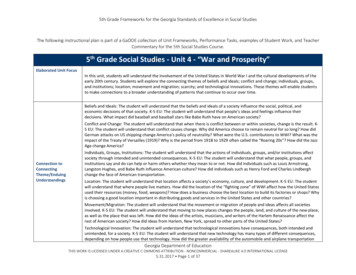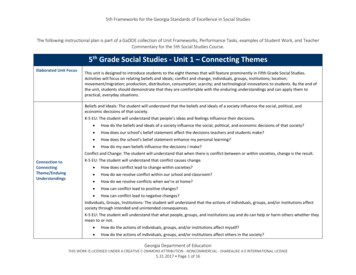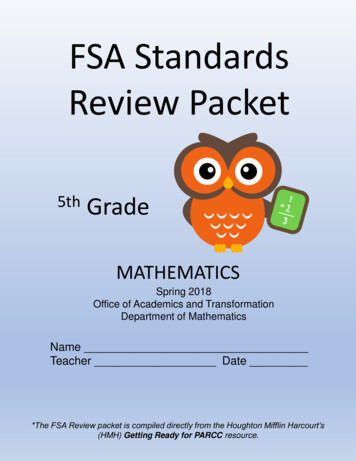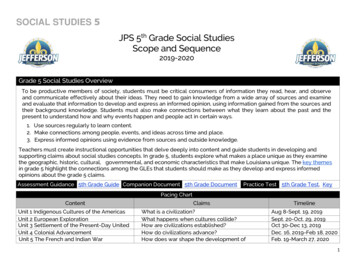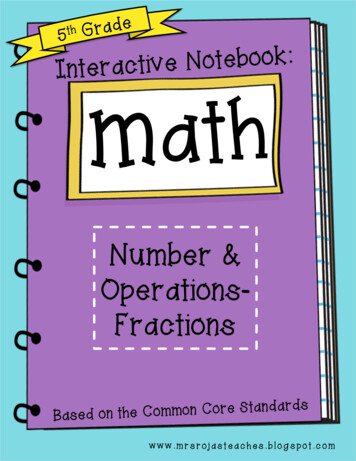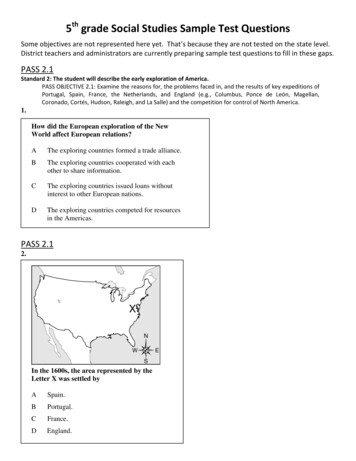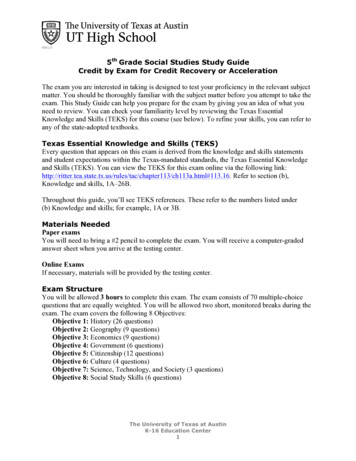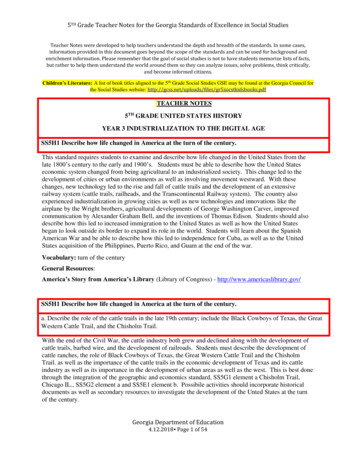
Transcription
5TH Grade Teacher Notes for the Georgia Standards of Excellence in Social StudiesTeacher Notes were developed to help teachers understand the depth and breadth of the standards. In some cases,information provided in this document goes beyond the scope of the standards and can be used for background andenrichment information. Please remember that the goal of social studies is not to have students memorize lists of facts,but rather to help them understand the world around them so they can analyze issues, solve problems, think critically,and become informed citizens.Children’s Literature: A list of book titles aligned to the 5th Grade Social Studies GSE may be found at the Georgia Council forthe Social Studies website: fTEACHER NOTES5TH GRADE UNITED STATES HISTORYYEAR 3 INDUSTRIALIZATION TO THE DIGITAL AGESS5H1 Describe how life changed in America at the turn of the century.This standard requires students to examine and describe how life changed in the United States from thelate 1800’s century to the early and 1900’s. Students must be able to describe how the United Stateseconomic system changed from being agricultural to an industrialized society. This change led to thedevelopment of cities or urban environments as well as involving movement westward. With thesechanges, new technology led to the rise and fall of cattle trails and the development of an extensiverailway system (cattle trails, railheads, and the Transcontinental Railway system). The country alsoexperienced industrialization in growing cities as well as new technologies and innovations like theairplane by the Wright brothers, agricultural developments of George Washington Carver, improvedcommunication by Alexander Graham Bell, and the inventions of Thomas Edison. Students should alsodescribe how this led to increased immigration to the United States as well as how the United Statesbegan to look outside its border to expand its role in the world. Students will learn about the SpanishAmerican War and be able to describe how this led to independence for Cuba, as well as to the UnitedStates acquisition of the Philippines, Puerto Rico, and Guam at the end of the war.Vocabulary: turn of the centuryGeneral Resources:America’s Story from America’s Library (Library of Congress) - http://www.americaslibrary.gov/SS5H1 Describe how life changed in America at the turn of the century.a. Describe the role of the cattle trails in the late 19th century; include the Black Cowboys of Texas, the GreatWestern Cattle Trail, and the Chisholm Trail.With the end of the Civil War, the cattle industry both grew and declined along with the development ofcattle trails, barbed wire, and the development of railroads. Students must describe the development ofcattle ranches, the role of Black Cowboys of Texas, the Great Western Cattle Trail and the ChisholmTrail. as well as the importance of the cattle trails in the economic development of Texas and its cattleindustry as well as its importance in the development of urban areas as well as the west. This is best donethrough the integration of the geographic and economics standard, SS5G1 element a Chisholm Trail,Chicago IL., SS5G2 element a and SS5E1 element b. Possibile activities should incorporate historicaldocuments as well as secondary resources to investigate the development of the Unted States at the turnof the century.Georgia Department of Education4.12.2018 Page 1 of 54
5TH Grade Teacher Notes for the Georgia Standards of Excellence in Social StudiesOne way would be to explain to students that they will be learning about how different regions of theUnited States developed after the Civil War. Model for students how the United States can be dividedinto regions following the Civil War using a 1870’s - 1890’s map of the United States. Have studentslabel the map with the North, which after the Civil War becomes the Northeast, the South, Midwestregion and the West. Explain that each of these regions develops different economic activities based onthe climate, population, and other factors. They will discover what and how these economies developedand what influenced the regions’ development, such as access to water and other natural resources.This overview of the regions could be done by students through the use of four different historicaldocuments. Explain that each document represents a region of the United States. Explain meaning ofterms primary source and secondary source. In cooperative groups, students will read documents anddetermine the various living environments as well as what the text is describing as the way individualsearned a living in that area.Possible primary and secondary resources include:Document 1:Quote from a business owner (Northeast)I regard my people as I regard my machinery. So long as they do my work for what I choose to paythem, I keep them, getting out of them all I can. What they do or how they fare outside my walls I don’tknow, nor do I consider it my business to know. They must look out for themselves as I do for myself.Source: Massachusetts Bureau of Statistics of Labor, Thirteenth Annual Report, arysource/viewdetails.aspx?TopicId &PrimarySourceId 1218Georgia Department of Education4.12.2018 Page 2 of 54
5TH Grade Teacher Notes for the Georgia Standards of Excellence in Social StudiesDocument 2:Quote from a John Wesley Hardin (Midwest: Cattle Trails)“About the last of February we got all our cattle branded and started for Abilene, Kansas, about the 1stof March. Jim Clements and I were to take these 1,200 head of cattle up to Abilene and Manning; Gipand Joe Clements were to follow with a herd belonging to Doc Bumett. Jim and I were getting 150per month.Nothing of importance happened until we got to Williamson County, where all the hands caught themeasles except Jim and myself. We camped about two miles south of Corn Hill and there we rested upand recruited. I spent the time doctoring my sick companions, cooking, and branding cattle.After several weeks of travel, we crossed Red River at a point called Red River Station, or Bluff, northof Montague County. We were now in the Indian country and two white men had been killed byIndians about two weeks before we arrived at the town. Of course, all the talk was Indians andeverybody dreaded them. We were now on what is called the Chisum [Chisholm] Trail and game of allkinds abounded: buffalo, antelope, and other wild animals too numerous to mention. There were agreat many cattle driven that year from Texas. The day we crossed Red River about fifteen herds hadcrossed, and of course we intended to keep close together going through the Nation for our mutualprotection. The trail was thus one line of cattle and you were never out of sight of a herd. I was justabout as much afraid of an Indian as I was of a coon. In fact, I was anxious to meet some on thewarpath.”Source: http://spartacus-educational.com/WWcattkeD.ht m1) John Wesley Hardin, Life of John Wesley Hardin as Written by Himself (1896)Georgia Department of Education4.12.2018 Page 3 of 54
5TH Grade Teacher Notes for the Georgia Standards of Excellence in Social StudiesDocument 3:Quote from a California Gold Miner, James Wilson Marshall (West)“We pitched our tents, shouldered our picks & shovels & with pan in hand sallied forth to try ourfortunes at gold digging. We did not have very good success being green at mining, but by practice &observation we soon improved some, & found a little of the shining metal. ""It is found along the banks of the streams & in the beds of the same, & in almost every little ravineputting into the streams. And often from 10 to 50 ft. from the beds up the bank. We sometimes have todig several feet deep before we find any, in other places all the dirt & clay will pay to wash, butgenerally the clay pays best. If there is no clay, then it is found down on the rock. All the lumps arefound on the rock--& most of the fine gold. We tell when it will pay by trying the dirt with a pan. This iscalled prospecting here. If it will pay from six to 12 1/2 pr pan full, then we go to work. Some wash withcradles some with what is called a tom & various other fixings. But I like the tom best of any thing that Ihave seen.It is a box or trough about 8 or 9 feet long, some 18 in. wide & from 5 to 6 in. high, with an iron sieve inone end punched with 1/2 in. holes. Underneath this is placed a ripple or box with two ripples across it.The tom is then placed in an oblique position the water is brought on by means of a hose. The dirt, stone,clay & all is then thrown in & stirred with a shovel until the water runs clear, the gold & finer gravelgoes through the sieve & falls in the under box & lodges above the ripples. Three men can wash all daywithout taking this out as the water washes the loose gravel over and all the gold settles to the bottom.One man will wash as fast as two can pick & shovel it in, or as fast as three rockers or cradles."Source: ush.htmDocument 4:Quote from a Touring Actor Observations of Pittsburgh, 1833“No city in the United States is more romantically situated, or can boast of finer scenery in itsimmediate neighborhood. Situated on the banks of the two rivers, the Monongahela andAllegheny, whose junction at this point form the Ohio River, the City of the Three Rivers, cloudedas it is in endless smoke from its numerous factories, possesses advantages not often met in amanufacturing town. A walk of a quarter of an hour in any direction places you above the smoke,so much complained of by strangers, and presents to the view landscapes in which the eye of anartist revels with delight, and shady retreats upon its hills, where, free from observation, they canwander and ponder upon the endless source of wealth which the coal mines beneath their feet pourdaily into this city of industry.”Francis Courtney Wemyss, a touring ay/primarysource/viewdetails.aspx?TopicId &PrimarySourceId 1033Georgia Department of Education4.12.2018 Page 4 of 54
5TH Grade Teacher Notes for the Georgia Standards of Excellence in Social StudiesGeorge Washington CarverGeorge Washington Carver was born a slave inDiamond Grove, Missouri, around 1864. He isone of the nation's most famous agriculturalscientists. He is best known for his research onpeanuts and his commitment to helping poorSouthern African American farmers.Carver worked at Tuskegee Institute in Alabamafor most of his adult life. In 1943, soon afterCarver's death, President Franklin D. Rooseveltmade Carver's boyhood home a nationalmonument. It was the first national monument tohonor an African American.Excerpt: America’s Story from America’sLibrarySource Text: http://www.americaslibrary.gov/aa/carver/aa carver subj.htmlImage: https://www.loc.gov/item/2001703725/For this element, students need to understand the purpose of cattle trails in general, and can identify theimportance of the trails. Cattle trails were important to the growth of the Western territories and states.Cattle ranches in Texas fed large numbers of people in the East and eventually in the West. This growthwas due to the development of the railroads. As rail lines and railheads developed, cattle were shippedquickly over long distances where larger profits were possible in urban areas. Two specific cattle trailsare highlighted in this standard: The Chisholm Trail and the Great Western Cattle Trail. Note that thegeography standard SS5G1b requires students to be able to locate both trails.The two specific cattle trails that are emphasized in this standard are significant in the cattle industry inthe west. The Great Western Trail existed both north and south of Dodge City, Kansas, and allowedranchers to move large numbers of cattle to this railroad hub for conveyance further east. The ChisholmTrail allowed cowboys to take cattle from the ranches of Texas to railroad hubs in Kansas. Interestingly,this trail was named for Jesse Chisholm, of Cherokee ancestry, who blazed the trail in his wagon in 1866.He traveled through modern-day Oklahoma to his trading post near Wichita. Later, ranchers followed histrail with cattle. This was a remote trail, which allowed the cowboys to move cattle quickly to railwayhubs or heads in Kansas. Over time, the development of the railroad across Texas as well as thedevelopment of barb wire [also known as barbed wire] made cattle drives less necessary. Students mustbe able to describe how these trails were essential in the development of the West, and in its role inproviding beef to feed those in the growing industrialized cities of the East.Great Western Cattle htmlThe Chisholm Trail Heritage Center – map and information about the trailhttp://onthechisholmtrail.com/historians/The Texas Historical Commission – maps, timelines, information, and many great primary sourceimages located here: s/chisholm-trail.pdfGeorgia Department of Education4.12.2018 Page 5 of 54
5TH Grade Teacher Notes for the Georgia Standards of Excellence in Social StudiesPBS – The Cattle Drives – features a lesson plan on the drives and more detail about life on a cattleranch. ring this time the Black Cowboys of Texas gained historical prominence in their assistance indeveloping the cattle industry in Texas. Some had previously been enslaved, and others were thedescendants of former slaves. Large numbers of these people worked as ranch hands driving cattle torailheads in Kansas and Oklahoma. Following the Civil War life was better on the open range, wherethey experienced less open discrimination than in the south and more urban environments. Students maywant to find out more about individual Black cowboys of Texas such as Nat Love, Bose Ikard, Isom Dart,and Bill Pickett.Vocabulary: cattle trails, cowboys, railroads, territories, 19th centuryResources:For more about the Black Cowboys of Texas, visit:Texas State Historical Association – information, images, and les/arb01PBS, Texas Ranch House - Information on specific Black Cowboyshttp://www.pbs.org/wnet/ranchhouse/pop blackcowboy.htmlSmithsonian article: Good teacher background on the Black Cowboys may be found here.“The Lesser Known History of African-American Cowboys,” by Katie Nodjimbadem, Feb. 13, 2017,found at: -history-african-american-cowboys180962144/SS5H1 Describe how life changed in America at the turn of the century.b. Describe the impact on American life of the Wright brothers (flight), George WashingtonCarver (science), Alexander Graham Bell (communication), and Thomas Edison (electricity).To demonstrate mastery of this element, students should describe each inventor, their listed significantcontribution, and how their contributions changed life at the end of the 19th century in America. Dates areprovided for teacher reference rather than student memorization. This standard incorporates the standardSS5G1a. locate important places - Kitty Hawk, NCThe Wright Brothers (Orville and Wilbur) went intobusiness as bicycle salesmen in Ohio in the late 19thcentury. Like many scientifically minded people of their era,they were fascinated by the possibility of machines thatwould allow humans to fly. In 1903, their glider survived a12-second flight from the dunes at Kitty Hawk, NorthCarolina. Others were working simultaneously toward thisachievement, and the Wright Brothers’ flight ignited anational passion for aviation. Within two decades, airplanescould fly distances previously thought to be impossible. In afew short decades, airplanes would develop to the point that they began to be used for military purposesas well. Photo of the glider flight at Kitty Hawk, 1902, public domain.Vocabulary: flight, scientific, inventor, contribution, aviationResources:Georgia Department of Education4.12.2018 Page 6 of 54
5TH Grade Teacher Notes for the Georgia Standards of Excellence in Social StudiesNational Park Service – Wright Brother National Memorial: For more about the Wright Brothers’work with flight, visit: http://www.nps.gov/wrbr/index.htm.Smithsonian National Air and Space Museum – background info, lesson plans, activities, primarysources: hers/online/History Channel: Wright Brothers – information, photos, and more (site has ads, use for teacherbackground only) othersGeorge Washington Carver was born a slave, but rose to become one of our nation’s most famousagricultural scientists. He was invited to teach at the Tuskegee Institute in 1896 by Booker T.Washington. It was there that he researched methods to improve agricultural production. Carver is mostknown for his research on peanuts and his commitment to helping struggling Southern African Americanfarmers. Most notably, he has been credited with teaching southern farmers to rotate crops to replenishnutrient depleted soil. In fact, Carver introduced Georgian farmers to the benefits of rotating cotton cropswith peanut crops to replenish the soil with nutrients. Thus, he helped establish peanuts as an importantagricultural crop in Georgia. Carver developed more than 300 uses for peanuts including peanut milk,peanut paper, and peanut soap.Vocabulary: scientist, agriculture, research, crop rotation, nutrient, depletion, replenishResources:Source: Educational resources, visit websites:Field Museum – biographical information, photo gallery, and other educational esources.aspNational Park Service Carver National Monument - information, photos, and further background at:https://www.nps.gov/gwca/index.htmCarver has been featured in United States stamps several times.Explore how people are chosen to be pictured on a stamp and haveyour students design their own stamp highlighting Carver’scontributions. https://arago.si.edu/category 2028793.htmlExplore photos and portraits of Carver at the Smithsonian’s NationalPortrait Gallery, including the one at the right. Use such artworks orphotographs to have your students think likehistorians. Have them ask questions like what isin the painting, how did the artist choose what toput in and what to leave out, and what “story” ofCarver does the image tell. Find more at:http://npg.si.edu/portraits and search for “George Washington Carver.”For further teacher background information on Carver, see: tute/Georgia Department of Education4.12.2018 Page 7 of 54
5TH Grade Teacher Notes for the Georgia Standards of Excellence in Social StudiesAlexander Graham Bell is famous for his invention of the telephone. He was also an audiologist, speechtherapist and teacher of the deaf. The telephone, inventedin 1876was a device that was almost immediately popular, andbecameso affordable that over time nearly every Americanhousehold contains at least one telephone. The telephonedramatically changed communication throughout thecountry. Students might be very interested to see howtelephones have changed over the years, and could exploreearlytelephone development with party lines, telephoneoperators, and other aspects of this transformational tool ofcommunication.Photo of Alexander Graham Bell, around 1922Vocabulary: telephone, device, affordable,communication, telephone operator, designResources:Library of Congress – The Alexander Graham Bell Papers, 1862-1939; design sketches, timelines,biographical information, collection highlights abundantly rich sources for students to ials/connections/alexander-graham-bell/Article on the history of the Telephone by Jason Morris – covers a lot of information in a concise way.ITPA – Independent Telecommunications Pioneer Association - Includes photos, timelines, andextensive support information. ography channel: Alexander Graham Bell – biographical information, photos, video clips offerextensive background information for teachers; site contains am-bell-9205497Georgia Department of Education4.12.2018 Page 8 of 54
5TH Grade Teacher Notes for the Georgia Standards of Excellence in Social StudiesThomas Edison, the wizard of Menlo Park was an inventor who has been credited with creating over a1000 inventions. One invention he is credited with is a long-lasting filament for the electric light bulb.He is also known for developing the phonograph or record player as well as developing motion pictures.His inventions very much relied on electricity and creating machines that used electricity to solveproblems for and enhancing everyday life. He was not only an inventor but also was a successfulbusinessman, marketer, and manufacturer.Vocabulary: inventions, credited, filament, phonograph, motion pictures, enhancing, businessman,marketer, manufacturer, genius, creationResources:Smithsonian Magazine -article for teacher background (site has ads), “7 Epic Fails Brought to You Bythe Genius Mind of Thomas Edison,” by Erica S. Hendry, November 20, 2013 edison-180947786/Library of Congress resources on Edison – biography, timeline, primary source set, and more history-thomas-a-edisonLibrary of Congress Edison motion picture – see this motion picture of a man sneezing recorded bfyEdison. https://www.loc.gov/item/00694192PBS: American Experience: Thomas Edison – excellent information, video clips, primary sources andother activities concerning this most amazing /films/edison/History Channel on Thomas Edison – biographical information, primary sources, good for teacherbackground (site has ads) isonOne possible activity could be to allow students to research each inventor using various websites and byusing historical documents. As students gather information about each inventor they could discuss theInventors at the Turn of the CenturyThink About What didthisinventorcreate?Where wasthisinventioncreated?Describe how thisinvention affected lifeat the turn of xanderGraham BellThomasEdisonGeorgia Department of Education4.12.2018 Page 9 of 54Use evidence tosupport a descriptionof why this inventorcreated this invention.
5TH Grade Teacher Notes for the Georgia Standards of Excellence in Social Studiesimportance of the inventor’s invention(s) as well as the effect this invention had on the United States atthe turn of the century. Students could then present the information in various audio-visual andtechnological formats.SS5H1 Describe how life changed in America at the turn of the century.c. Explain how William McKinley and Theodore Roosevelt expanded America’s role in theworld; include the Spanish-American War and the building of the Panama Canal.To demonstrate mastery of this element, students must describe how William McKinley and TheodoreRoosevelt expanded the United States’ role in the world. Students must be able to explain the impact ofthe Spanish-American War on the United States’ role in the world, and why the Panama Canal aided inthis expansion.Students must realize that while the United States was rebuilding after the Civil War, much of Europe wasfollowing a policy of imperialism and was colonizing Africa and Asia. These countries were competingfor power and influence. European countries like Great Britain, France, Germany, and Spain wanted togain land, natural resources, and markets to aid in their industrial development. Meanwhile, at the sametime, a technological explosion and westward expansion led to rapid growth in the United States.American statesmen watched what was happening overseas and were divided as to whether the UnitedStates should join in this “scramble” for an empire. Under President William McKinley, this issue eruptedwhen the United States military engaged with Spanish forces in the Philippines and Cuba. This war, theSpanish-American War, was fueled partly by American interests in the western hemisphere, as well as bypublic opinion. Newspapers created sensationalized news stories that outraged citizens about the unfairtreatment of the Cuban people. In a desire to sell newspapers, articles and photographs about the sinkingof the USS Maine were published, blaming its sinking on Spain. Some historians blame this war on theidea of yellow journalism or biased coverage, which helped fuel public support of the war. The shortconflict led to the removal of Spain from Cuba, and increased American popular interest in obtainingcolonies abroad. Thus, the United States gained control of the Philippines, Puerto Rico, and Guam.Vocabulary: expansion, role, imperialism, colonization, overseas, empire, military, engaged,sensationalized, yellow journalism, biasedResources:Primary Source Nexus, Library of Congress – many primary sources of all types on the SpanishAmerican War: ican-warLibrary of Congress: The Spanish American War in Motion Pictures, and other valuable sites:https://www.loc.gov/search/?in &q Spanish American War&new trueEyewitness to History, “The U.S. Declares War on Spain, 1898” good for teacher background (ads onsite): yewitness to History, “The Battle of Manila Bay, 1898” good for teacher background (ads on .htmGeorgia Department of Education4.12.2018 Page 10 of 54
5TH Grade Teacher Notes for the Georgia Standards of Excellence in Social StudiesTheodore Roosevelt (public domain image, Library of Congress)emerged as a hero of the Spanish American War, and succeededMcKinley as President when McKinley was assassinated in 1901.During the war, Roosevelt led a group of volunteer cavalrymenknown as Rough Riders on a famous charge at the Battle of San JuanHill (also known as San Juan Heights). His heroism stood him in goodstead when he became the youngest president in 1901. His policychoices as President included issuing Roosevelt’s Corollary, whichconfirmed the longstanding tradition created by the Monroe Doctrinein 1805, of American intervention in hemispheric affairs. DuringRoosevelt’s tenure as President, construction finally began on thePanama Canal. Explore with your students the pro’s and con’s of thiscanal project, and how the canal was beneficial to the United States.Vocabulary: expansionism, canal, volunteer, cavalrymen, heroism,policy, intervention, construction, beneficialResources:National Park Service: Theodore Roosevelt Birthplace – “T.R. the Rough Rider: Hero of the SpanishAmerican War” biographical information of this episode of TR’s /tr-rr-spanamwar.htmEyewitness to History – multiple topics provide good teacher background (ads on site)“A Walk With President Roosevelt, 1908,” explains about the strenuous lifestyle for which hewas famous. tm“The Roosevelts Move into the White House, ouse.htm“The Rough Riders Storm San Juan ghriders.htmSS5H1 Describe how life changed in America at the turn of the century.d. Describe the reasons people immigrated to the United States, from where they emigrated,and where they settled.For mastery of this element, students must describe various ethnic groups that immigrated to the UnitedStates during the latter half of the 19th century and early 20th century. Students should identify regionsand countries from which people emigrated, and describe factors that led to their migrations. Studentsshould explain that people migrated due to various reasons. These push and pull factors resulted in largenumbers of immigrants arriving in immigration stations located on Ellis Island in New York City andAngel Island in San Francisco. Push factors that led people to immigrate included religious and politicalupheaval, persecution, and economic instability. In contrast, people who left Europe were lured toAmerica with promises of free, rich land for farming, jobs, and for opportunities to have a better life.These positive changes are often referred to as pull factors. Upon arrival in the United States immigrantsoften encountered crowded cities, harsh living and working conditions, and discrimination.Georgia Department of Education4.12.2018 Page 11 of 54
5TH Grade Teacher Notes for the Georgia Standards of Excellence in Social StudiesThe initial wave of European immigrants consisted mostly of people from Ireland and Germany. They leftbehind countries that faced civil unrest, severe unemployment, famine, and inconceivable hardships. Thisstream slowed over time, and an increased number of immigrants from southern and eastern Europearrived. While German and Irish immigrant groups congregated on the east coast, Chinese immigrantsmigrated to California and to western territories and states. They were lured there by economicopportunities created through the development of the transcontinental railroad and other rail lines as wellas the promise of gold discovered in California. During the late 1860’s increased immigration fromSweden, Norway, Denmark, and Finland occurred. These immigrants left the eastern regions of theUnited States to farm and live in the communities in th
5TH Grade Teacher Notes for the Georgia Standards of Excellence in Social Studies Georgia Department of Education 4.12.2018 Page 5 of 54 for most of his adult life. In 1943, soon after For this element, students need to understand the purpose of cattle trails i
